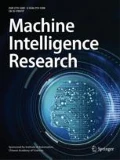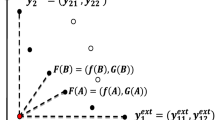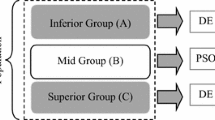Abstract
The optimal test sequence design for fault diagnosis is a challenging NP-complete problem. An improved differential evolution (DE) algorithm with additional inertial velocity term called inertial velocity differential evolution (IVDE) is proposed to solve the optimal test sequence problem (OTP) in complicated electronic system. The proposed IVDE algorithm is constructed based on adaptive differential evolution algorithm. And it is used to optimize the test sequence sets with a new individual fitness function including the index of fault isolation rate (FIR) satisfied and generate diagnostic decision tree to decrease the test sets and the test cost. The simulation results show that IVDE algorithm can cut down the test cost with the satisfied FIR. Compared with the other algorithms such as particle swarm optimization (PSO) and genetic algorithm (GA), IVDE can get better solution to OTP.
Similar content being viewed by others
References
K. R. Pattipati, M. Alexandridis. Application of heuristic search and information theory to sequential fault diagnosis. IEEE Transactions on Systems, Man, and Cybernetics, vol. 20, no. 4, pp. 872–887, 1990.
V. Raghavan, M. Shakeri, K. R. Pattipati. Optimal and near-optimal test sequencing algorithms with realistic test models. IEEE Transactions on Systems, Man, and Cybernetics, vol. 29, no. 1, pp. 11–27, 1999.
M. Shakeri, V. Raghavan, K. R. Pattipati, A. Patterson-Hine. Sequential testing algorithms for multiple fault diagnosis. IEEE Transactions on Systems, Man, and Cybernetics, vol. 30, no. 1, pp. 1–14, 2000.
Z. Hu, S. G. Zhang, Y. M. Yang, L. J. Song, Y. Liu. Test sequencing problem considering life cycle cost based on the tests with non-independent cost. Chemical Engineering Transactions, vol. 33, no. 3, pp. 253–258, 2013.
F. Tu, K. R. Pattipati, S. Deb, V. N. Malepati. Computationally efficient algorithms for multiple fault diagnosis in large graph-based systems. IEEE Transactions on Systems, Man, and Cybernetics, vol. 33, no. 1, pp. 73–85, 2003.
O. E. Kundakcioglu, T. Ünlüyurt. Bottom-up construction of minimum-cost and/or trees for sequential fault diagnosis. IEEE Transactions on Systems, Man, and Cybernetics, vol. 37, no. 5, pp. 621–629, 2007.
C. L. Dong, Q. Zhang, S. C. Geng. A modeling and probabilistic reasoning method of dynamic uncertain causality graph for industrial fault diagnosis. International Journal of Automation and Computing, vol. 11, no. 3, pp. 288–298, 2014.
J. S. Yu, B. Xu, X. S. Li. Generation of test strategy for sequential fault diagnosis based on genetic algorithms. Journal of System Simulation, vol. 16, no. 4, pp. 833–836, 2004. (in Chinese)
R. H. Jiang, H. J. Wang, B. Long. Applying improved AO* based on DPSO algorithm in the optimal test sequencing problem of large scale complicated electronic system. Chinese Journal of Computers, vol. 31, no. 10, pp. 1835–1840, 2008. (in Chinese)
G. Y. Lian, K. L. Huang, J. H. Chen, F. Q. Gao. Optimization method for diagnostic sequence based on improved particle swarm optimization algorithm. Journal of Systems Engineering and Electronics, vol. 20, no. 4, pp. 899–995, 2009. (in Chinese)
X. H. Qiu, J. Liu, X. H. Qiu. Random DBPSO algorithm application in the optimal test-sequencing problem of complicated electronic system. In Proceedings of the 2nd International Conference on Computer and Automation Engineering, IEEE, Singapore, vol. 1, pp. 107–111, 2010.
P. R. Srivatsava, B. Mallikarjun, X. S. Yang. Optimal test sequence generation using firefly algorithm. Swarm and Evolutionary Computation, vol. 8, pp. 44–53, 2013.
J. L. Pan, X. H. Ye, Q. Xue. A new method for sequential fault diagnosis based on Ant Algorithm. In Proceedings of the 2nd International Symposium on Computational Intelligence and Design, IEEE, Changsha, China, vol. 1, pp. 44–48, 2009.
Z. L. Pan, L. Chen, G. Z. Zhang. Cultural algorithm for minimization of binary decision diagram and its application in crosstalk fault detection. International Journal of Automation and Computing, vol. 7, no. 1, pp. 70–77, 2010.
C. L. Yang, J. H. Yan, B. Long, Z. Liu. A novel test optimizing algorithm for sequential fault diagnosis. Microelectronics Journal, vol. 45, no. 6, pp. 719–727, 2014.
J. Zhang, A. C. Sanderson. JADE: Adaptive differential evolution with optional external archive. IEEE Transactions on Evolutionary Computation, vol. 13, no. 5, pp. 945–958, 2009.
Y. Wang, Z. X. Cai, Q. F. Zhang. Differential evolution with composite trial vector generation strategies and control parameters. IEEE Transactions on Evolutionary Computation, vol. 15, no. 1, pp. 55–66, 2011.
J. Kennedy, R. C. Eberhart. Particle swarm optimization. In Proceedings of IEEE International Conference on Neural Networks, IEEE, Piscataway, USA, vol. 4, pp. 1942–1948, 1995.
J. J. Liang, A. K. Qin, P. N. Suganthan, S. Baskar. Comprehensive learning particle swarm optimizer for global optimization of multimodal functions. IEEE Transactions on Evolutionary Computation, vol. 10, no. 3, pp. 281–295, 2006.
Acknowledgments
This work was supported by National Natural Science Foundation of Jiangxi Province, China (No. 20132BAB201044) and Jiangxi Higher Technology Landing Project, China (No.KJLD12071).
Author information
Authors and Affiliations
Corresponding author
Additional information
Recommended by Associate Editor Chandrasekhar Kambhampati
Xiao-Hong Qiu received the B. Sc. and M. Sc. degrees in automatic control from Beijing University of Aeronautics and Astronautics, China in 1989, 1992 respectively, and the Ph. D. degree in flight control, guidance and simulation from Beijing University of Aeronautics and Astronautics, China in 1995. From 1995 to 2002, he was a senior engineer and vice general manager in the Institute of Unmanned Vehicle, Beijing University of Aeronautics and Astronautics. Since 2002, he has been a professor of Jiangxi Agricultural University, Jiangxi Normal University, China. Currently, he is a professor in Software School at Jiangxi University of Science and Technology, China. He is the author of three books, and more than 70 articles. He was a recipient of Defense Science and Technology Progress Second Award in 2001.
His research interests include intelligent control and intelligent computing.
Yu-Ting Hu received the B. Sc. degree in electrical engineering and automation from Jiangxi University of Science and Technology, China in 2013. She is currently a master student in the Jiangxi University of Science and Technology, China.
Her research interests include the development of software and intelligent computing.
Bo Li received the B. Sc. degree in electrical engineering and automation from Jiangxi University of Science and Technology, China in 2002, and M. Sc. degree from School of Science, Jiangxi University of Science and Technology, China in 2005. Since 2005, he is a lecturer at Software School, Jiangxi University of Science and Technology, China.
His research interests include the development of software and intelligent algorithm.
Rights and permissions
About this article
Cite this article
Qiu, XH., Hu, YT. & Li, B. Sequential Fault Diagnosis Using an Inertial Velocity Differential Evolution Algorithm. Int. J. Autom. Comput. 16, 389–397 (2019). https://doi.org/10.1007/s11633-016-1008-0
Received:
Accepted:
Published:
Issue Date:
DOI: https://doi.org/10.1007/s11633-016-1008-0




